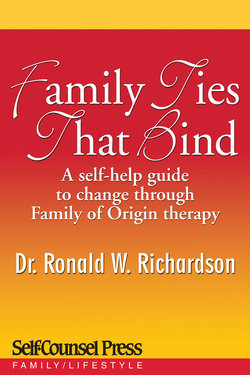Читать книгу Family Ties That Bind - Dr Ronald W. Richardson - Страница 9
На сайте Литреса книга снята с продажи.
2. Appearances Are Deceiving
ОглавлениеOne of the tricky things about closeness and distance is that most outwardly independent people are only pseudo-independent. They use distance as a way of controlling their fears about closeness. They may have tremendous needs for closeness, but have become afraid of it, so they distance instead.
The person who has no apparent need for closeness will choose for a partner someone who insists on togetherness. This partner represents the other side of the person’s own ambivalence about closeness and distance. The two of them will, in fact, have the same comfort level. However, the relationship will be turbulent because of their different ways of handling their needs for closeness or distance. They will fight over their emotional thermostat the way some people fight over the furnace thermostat setting. One turns it up and the other comes by and turns it down; neither is happy about the other person’s actions, but they manage to keep the temperature at a fairly constant level midway between their extremes.
The paradox of this is that even those who openly admit their need for togetherness are not usually capable of intimacy. True intimacy means having an accepting, open relationship with someone who is different from us. People who need constant closeness and togetherness have trouble accepting that others are not the same as them. They have trouble thinking of themselves separately. They talk about what “we think” and how “we feel” rather than what “I” think or feel. They insist: “We think about each other before we think about ourselves.” They talk about sacrificing for others and not being selfish. They espouse the values of love and compassion for others but often use those things in a manipulative way. They feel responsible for the happiness of others, and if someone is not happy ask, “What have I done wrong?” They also blame others for their own unhappiness.
Those who use distancing as a way of keeping the balance talk about lack of support, caring, or consideration from the pursuer who is nagging them. However, the favorite response of distancers is silence. They simply withdraw. They also say, “I don’t know,” as a way of avoiding an encounter with others.
But remember, even though they look very different, the pursuer and the distancer in a relationship have the same basic need for togetherness.
Try the following exercise to see how distancing and pursuing affect your relationships with people.
DISTANCING AND PURSUING
Decide whether you are usually a distancer or a pursuer. Then select a person who plays the opposite role in a significant relationship of yours. For a week, try playing the other person’s role — the opposite of what you are usually like with that person. Try doing a better job at playing that role than the other person does. If you are playing the distancer, be even more distant than the distancer usually is. Take note of what reactions and changes, if any, occur in both you and the other person.
Now do this with a parent or another family member where you tend to have one set pattern.What happens to both of you when you change this pattern?
